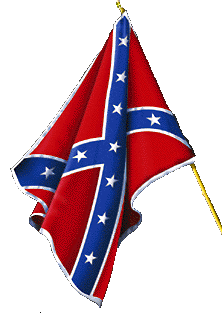
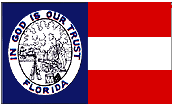
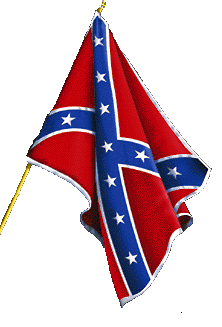



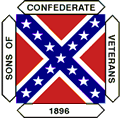

Pvt. William Riley Milton Camp 741
Sons of Confederate Veterans

Volume 10 Commander Terry Binkley Issue 4

![]()
Commander's Corner
Greetings Compatriots,
April is truly Confederate History Month whether the powers-that-be recognize it as such, or not. It was during April that the first shots of the War were fired on Ft. Sumter, Gen. Lee resigned from the U.S. Army, Gen. Forrest captured Ft. Pillow, the Confederate Congress met for the last time, and sadly, the surrender at Appomattox. These are just a few of the events that took place during the month of April that are connected to the Confederacy. The event that we hold most dear that occurs this month is of course Confederate Memorial Day. In Florida and several other Southern States, April 26th is a legal state holiday in honor of our Confederate dead. We will be conducting our annual service at the Glendale Cemetery in Umatilla on Saturday, April 23rd at 10:00 A.M. I cannot stress enough the importance of this service. I implore each member to come and be a part of this, our sacred duty as Sons of Confederate Veterans.
Brigade Commander Hurst is going to be representing Camp 741 at the Special Convention in Charlotte, N.C. on April 23rd. After discussion with the camp, I have asked him to vote in favor of the proposed amendments to the constitution and to fully support the elected leadership of our organization.
On Sunday April 17th, the Rodeheaver Boys Ranch is having their open house and BBQ. I, along with whomever else wants to go, will be there to present them with a donation of over $900 from Camp 741. $500 of it is our annual contribution to this very worthwhile cause, and the other approx. $470 came from the auction of a hand-made Confederate battle flag quilt donated and auctioned by Brig. Cmdr. and Mrs. Hurst. Thank you Harry and Karen!
We held our April meeting at the Fifth Street Char House, and quite frankly, I was very pleased with the place. We had complete privacy, the food, as well as the service was excellent and the staff was friendly and accommodating. The prices were a little higher than the 10 dollars we were charged at Golden Corral, but I’ve got to tell you, I think it was well worth the 3 or 4 more dollars to have the privacy and the service.
Let’s remember to keep Chaplain Dun Gordy and his wife, Harriett and family, in our prayers. They have been having a real battle with illnesses over the last few months.
I hope to see you on the 17th at the Boy’s Ranch, and most definitely want to see you at Glendale Cemetery on the 23rd, and don’t forget about Camp 770’s (Trenton) headstone dedication on the 30th, last but not least, see you at the Fifth Street Char House on May 3rd for our next camp meeting.
Y.O.S.
Terry
"If I ever disown, repudiate or apologise for the cause for which Lee fought and Jackson died, let the lightenings from Heaven rend me and the scorn of all good men and true women be my portion. Sun, moon and stars all fall on me when I cease to love the Confederacy. 'Tis the cause, not the fate of the cause, that is glorious"-- Major R. E. Wilson, C.S.A.
![]()
Chaplain’s Chat Rev. Dun Gordy
Will Return Next Month! Here is one of Dun's great articles from last year. Our prayers are with Dun, Harriet and their families.
Train Up a Child
“How do you justify that?” a student in my Bible college class asked me.
When I asked what he was referring to he pointed to the Battle Flag cover of my cell phone. “That symbol of slavery” was his reply.
Now this young scholar was not being ugly or accusative. Neither was he being willfully ignorant. But he was demonstrating the gross misinformation that he had been taught in his public school education.
“There are two things I want to tell you” I answered. “First of all, I’m real tired of other people telling me what my flag represents. And second, it was not about slavery!”
Like our beloved Bonny Blue Flag, the Battle Flag was never officially adopted by the government of the Confederate States of America. But the still popular red banner with white stars on crossing blue bars was the most common flag seen among the troops of the Confederacy. It was the symbol of “the Cause” as well as the standard of many military units.
And to this day it is a symbol to us, the descendant sons and daughters of those brave men who fought for the protection of our land. To us it is the symbol of men who were willing to fight, and if need be to die in defense of our invaded homeland. Neither my great grandfather nor any of his four brothers who served the Confederacy were slave owners.
To think that a mother and father would allow, much less send their sons off to risk their lives so that someone else could own slaves is ridiculous. And if the mother’s of the Gordy clan before The War were anything like their female descendants that I have known on this side of the conflict, fighting armed Yankees would have been far less risky than telling Mother that you were going off up north to war. But Mary Scott Gordy sheared her own sheep, spun the wool and made the uniforms that her five sons wore off to battle. And the uniforms they wore when two of them were killed and another wounded.
I was given a vivid illustration of how teachers are aggressively feeding our youth their revised version of the facts. While teaching in the Bible College here in Michigan, one of our staff members asked me to talk to his son about the “civil war”. His 3rd class was going to have “civil war” day and the young man had dressed up in a yankee uniform and carried his little musket with pride. He showed me how he had been taught to carry his gun, salute and to march. Then I asked him “Why did they fight a War Between the States?” To him it was pretty simple, cut and dried. “People in the south had slaves and the United States had to go and get them free,” was his explanation.
I don’t think he quite expected the little history lesson he got from this Bible professor, but sure got one! And I tried to impress on his father HIS responsibility to see that his son got accurate teaching.
Christian fathers and mothers are aware that the Scriptures teach us in Proverbs 22:6 to “train up a child in the way he should go…” And I’m convinced that instruction is not limited strictly to “spiritual matters.” We know that it is up to us to teach them to brush their teeth, mind their parents as well as love God and read His Word. And I believe it is just as important that we to see to it that they are taught the truth history of our great Republic.
Never has it been more urgent that we heed and obey the charge given to us Sons of Confederate Veterans by General Stephen Dill Lee in 1906: "Remember, it is your duty to see that the true history of the South is presented to future generations."
![]()
Confederate Veteran
History of Confederate Memorial Work
(by the Editor; CONFEDERATE VETERAN)
An address has been published by members of the Ladies’ Confederate Memorial Association of Atlanta to all Memorial Associations of the South, requesting them to formulate a history of their organizations, all to be published in one volume as a tribute to the heroes of the Confederacy. The object of the move is the propagation of Southern history. The memorial associations have been organized ever since the war, and have done excellent work. They deem it wise to preserve a record of these acts. The resolution was offered by Mrs. Clement A. Evans, of Atlanta. The proposition was agreed to with enthusiastic unanimity, and a committee was appointed to correspond with memorial associations of all the Southern States in reference to the object.
The appeal expresses the belief that “no trust more sacred ever fell into the keeping of any people than that which was committed to Southern women at the close of the bloody war in which so many brave and true men died for the land they loved and the cause in which they believed and for which they sacrificed all things, save their honor. For more than a quarter of a century, the ladies’ memorial associations have lovingly and tenderly commemorated the patriotism and valor of our Confederate dead by strewing upon their graves the fairest flowers our Southern land produces. They have discharged this trust in the recall of their own bereavements and in sympathy with those who were mourning like themselves. But they also sought to declare by their annual tender observance of Memorial Day how greatly they prized the chivalric character of the noble Southern men who are sleeping the last sleep of the brave in the hero’s grave. These impressive annual ceremonies have had an influence which has preserved and strengthened the truest and most exalted virtues in the lives of the generation that has arisen since the Confederate war, while they have contributed beyond calculation to the patriotic spirit of our countrymen everywhere. For these and other good reasons, we think that a full record should be made of the noble work for perpetual preservation. Such history should not be permitted to remain unrecorded. Not that we would seek our personal glory, but because posterity should know the character of Southern womanhood and emulate it, we would have the transactions of all memorial associations collected, compiled, and preserved. We feel that you will enter cordially into the spirit of this movement, and therefore, without hesitation, we lay before you the suggestion that you direct your secretary or some equally competent person to write a full account of the original organization of your association, and also a historic account of the work it has done in observing Memorial Day, in caring for soldier’s graves, and in all other patriotic offices rendered in memory of our Confederate dead or in aid of the Confederate living. It is also respectfully suggested that the organization of memorial associations be preserved, because it is in itself a monument to the memory of our heroes and because its work is as sacredly tender as ever. Its peculiar and single work of caring for the last resting-places of brave soldiers is as imperatively needed as ever, and its long continuance in that duty only heightens the desire that it shall perpetually observe Memorial Day. After all these years of devotion and faithful service let us now gather together the work of all our sister associations in one memorial volume as a tribute ‘to the heroes from the heroines of the South.’ Trusting that we shall have a general meeting of the ladies’ memorial associations at the next reunion of United Confederate Veterans, in 1898, we respectfully and earnestly request, through the courteous press of our country, that you have prepared at once a succinct history of your own association, including roll of its members from the beginning until now, and forward a copy by mail to the address of the chairman, Mrs. Clement A. Evans, Atlanta, Ga.
(From the February, 1898 CONFEDERATE VETERAN)
![]()
"Remembrance Book"
This month’s ancestor is Jasper Jackson Dykes, yet another of Lake County's pioneers. Mr. Dykes was born January 12, 1842 in Clay County, Florida, to George D. Dykes and Mary R. Hurst. He was one of 6 sons and 2 daughters in the family. His younger brother, Elbert Duncan Dykes, was also a Confederate veteran and pioneer of Lake County. In 1843-44 the family had moved to the western part of St. Johns County, then on to Benton County, which would later become Hernando County. Jasper's mother would die of complications from the birth of his sister Elizabeth in 1846, leaving Jasper and his siblings without their mother for most of their childhood. By 1861 Jasper had resettled in the area of the headwaters of the Oklawaha River on the south shore of Lake Griffin in a place called Silverton, later to become Leesburg. With the outbreak of war, Jasper and Elbert traveled to Flotard Pond, near Palatka, Florida to enlist in Capt. Hopkins' mounted company attached to the 4th Florida Volunteer Regiment. Pvt. Dykes participated in many skirmishes along the St. Johns River with his company being attached to Capt. J. J. Dickison's force. Jasper was slightly wounded in the face on July 26, 1864, in a skirmish with the Yankees at the railroad bridge over the St. Mary's River, but only missed action for about a week. The 2nd Florida Cavalry saw action from Jacksonville, to Fort Myers, to Cedar Key , to Alabama. Almost a year later Jasper laid down his arms as part of the general surrender and was enrolled as a prisoner at Waldo, Florida. He was paroled immediately upon taking the oath of allegiance and he returned to the Lake Griffin area and the newly renamed Leesburg. Private Jasper Dykes was now private citizen Jasper Dykes. Jasper would later marry Sarah Ellen Robertson, move to Fort Mason, in Lake County, and together would raise eight children on the shores of Lake Eustis. Sarah would pass on early in life leaving Jasper to finish raising the last of their teenage children. The Big Freeze of 1894-1895 wiped out the prospering groves of the Dykes family causing Jasper to move to Miami to try his hand at business there. His business prospered as Henry Flagler brought the Florida East Coast Railroad to the port of Miami. In 1911, Elbert Dykes, Jasper's younger brother was killed when a loaded wagon was pulled over him. This may have precipitated Jasper Dykes' return to Lake County. He is recorded as living in Altoona as of 1913. On August 18, 1913, Jasper Dykes' long and eventful life came to an end. Jasper Jackson Dykes is buried in Lake County, Florida. Exactly where is still being researched. Family history states he was interred near his wife in the Fort Mason Cemetery in Eustis, Florida but, there is a grave marker for Mr. Dykes in the Glendale Cemetery, Umatilla, Florida. This Confederate hero, Jasper Jackson Dykes was the Great Grandfather of another hero, World War II Medal of Honor winner, Robert M. McTureous, Jr., Lake County's only native son to win this nation's highest military honor.
We Shall Not Forget!
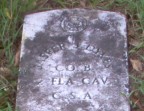
![]()
Our Camp
History/News/Notes
NEWS: Confederate Memorial Day Ceremony, April 23rd, 10 a.m. at Glendale Cemetery, Umatilla.
Directions: Go north on Hwy. 19 through downtown Umatilla. Turn left on Bulldog Way, just past the Pizza Hut, Turn right on Maxwell Rd. at the water tower, Glendale Cemetery is up on the left.
Next Meeting: May 3rd, 5th Street Charhouse in Leesburg, FL.!
Located at 114 S. 5th St. between Magnolia and Main St. in downtown Leesburg. 6 P.M. Supper, 7 P.M. Call to Order. Everyone seemed to like the new location! Plenty of parking at the bank across the street. Guests are always welcome!

Camp 741's Webpage is now archived and available on CD! The entire webpage for the years 2003 and 2004 are available including extra pictures not published on the web. This CD runs just like it was on the the internet without internet access. Get yours today! $5.00 for one, both for $7.00. Ask Terry or Jim.
